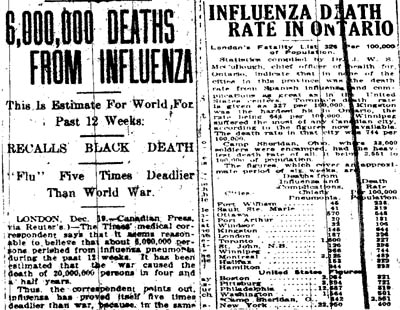EVENT

Flu Pandemic
1918-1919EVENT TYPE World History
As the First World War drew to a close, a new killer emerged. Commonly called the "Spanish Flu," the infection was brought back from Europe by returning soldiers. It claimed lives on every continent save Antarctica, and ultimately "killed more people than the guns of World War I" ("Worldwide"). In an attempt to control the outbreak, Vancouver officials banned late shopping, and closed theatres and churches. Nonetheless, eight hundred local residents were killed.
The transmission of the flu was facilitated by the "disruption, stress, and privation of war" ("Worldwide"), which made individuals more vulnerable to infection, and by its resistance to treatment. Doctors attempted to combat the contagion with "quinine tablets, bleeding, castor oil, digitalis, morphine, enemas, aspirin, tobacco, hot baths, cold baths, iron tonics, and expectorants of pine tar" ("Worldwide"), but to no avail. The only viable option was to try and restrict the spread of the virus. In addition to limiting public gatherings, some local governments "made it illegal to spit, cough, or sneeze in public" ("Worldwide"), while many individuals tried to reduce their own exposure to the infection through the use of gauze masks soaked in camphor and similar substances.
Media of the period were so consumed with issues of war and peace that the pandemic received little attention. To this day, not much is known about the virus, which sparked "the most dire epidemic since the Middle Ages, the third worst in recorded history" ("Worldwide").
The transmission of the flu was facilitated by the "disruption, stress, and privation of war" ("Worldwide"), which made individuals more vulnerable to infection, and by its resistance to treatment. Doctors attempted to combat the contagion with "quinine tablets, bleeding, castor oil, digitalis, morphine, enemas, aspirin, tobacco, hot baths, cold baths, iron tonics, and expectorants of pine tar" ("Worldwide"), but to no avail. The only viable option was to try and restrict the spread of the virus. In addition to limiting public gatherings, some local governments "made it illegal to spit, cough, or sneeze in public" ("Worldwide"), while many individuals tried to reduce their own exposure to the infection through the use of gauze masks soaked in camphor and similar substances.
Media of the period were so consumed with issues of war and peace that the pandemic received little attention. To this day, not much is known about the virus, which sparked "the most dire epidemic since the Middle Ages, the third worst in recorded history" ("Worldwide").
PHOTO GALLERY
Click on thumbnail for larger image

BIBLIOGRAPHY
Macdonald, Bruce. Vancouver: A Visual History. Vancouver: Talonbooks, 1992."Worldwide Flu Pandemic Strikes." A Science Odyssey: People and Discoveries. Home page. PBS Online. 27 Jan 2008. http://www.pbs.org/wgbh/aso/databank/entries/dm18fl.html








